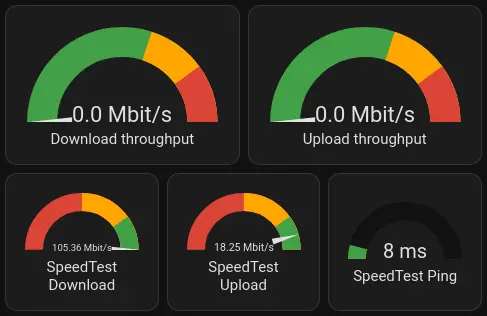

And the SM57 for things you don’t need a screen on.


And the SM57 for things you don’t need a screen on.


With a bit of luck, native RTC support means 2-way comms using reolink doorbells is close at hand.


People apparently rub them with IPA.
I need to have a try of this, as I regularly burn through 2032s.


I’ll just re-share mine from last time.
I tend to use the Horizontal Stack. On a mobile device, I just get one stack per line.
And on bigger screens, I get multiple stacks to make use of space.
General “Going out” page:

Internet speedtest page:



I’ll write a quick gist for anyone coming along:
One gas boiler in the house, each room has a smart TRV.
PIR sensor to set room presence, each window has an opening mag sensor.
HASS has a general presence sensor set.
Each room’s temperature is targeted based on presence and window status:
For each room, if person is home at all, and has been in the room for 5 mins, and the window is closed, TRV to 19, boiler on if <19.
If the room presence is negative and the window is closed, drop TRV target to 16.
If the window is open, drop the TRV target to 7.
There is a little more detail that that in the article, but that’s the basics.


I can only speak from a UK perspective, but most home ADSL/VDSL/Fibre providers don’t have limits, other than “if your usage is tanking the network, we’ll ask you to knock it off” type clauses.
Most providers are also signed up to an agreement that if your speed drops 50% below the agreed speed on the package on average, they’ll either give you refunds, or let you out of the contract.
The only ones that throttle are the bargain basement operators aimed at people who don’t care, and one otherwise very competent provider that for some unexplainable reason only gives 1TB by default, charging an extra £10 for 10TB.
And I guess there is also a pricing step up to guaranteed bandwidth. For business use, they tend to be things like 1gbits headline, 500mbit guaranteed burst, 100mbit guaranteed sustained.


z-wave may be easier than expected, as I think the devices stay linked to the hardware dongle used. (This is just from memory, mind!). But if you need to change the dongle, perhaps less fun.
imo, it will be a bit of pain to get everything inside HA, but once it’s done, you’ll be inside a platform that is pretty open, and commonly used, with lots of other people (hopefully) posting up solutions to problems before you encounter them!
And because it’s software that will run on pretty much anything, you have the reassurance that even if something crazy happened, you could just reinstall an old version.
If it were me, I’d clear an entire weekend day, power off the old kit, and work away at getting HA controlling everything.


Nice to see NC becoming involved with the board.
I don’t run that much z-wave due to cost, but I’m all for improvements and tighter integration.
Especially since when I do want to spend money, ZW works very well.
Kinda like the BeltBox, but less brightly coloured.


Or maybe something like this:
https://www.securemeters.com/uk/product/room-thermostats/hrt4-zw-asr/
The unit with the buttons on is a simple relay, which hass can control to turn things on and off, and use a heating control with a temperature sensor.
But if you hit the button on the front, it also gives 30 minutes of on, which can be handy if the system had issues.
Or you could have a hass controlled relay, but also leave the old controller wired in on a manual switch.
So if there was a failure, you could go back to the old control by manually flipping it over.
For most squishy remotes, you can disable the buttons by taking the remote apart, and putting tape on the underside of the rubber button.


Finally, a local WEEE company gets to make a few hundred bucks selling off the glorified VOC sensors at the end.
After a long day operating Hitachi heavy machinery, soothe your muscles with a Hitachi back massager.
A low-wiring way to do it would be to replace the bulbs with hue/similar bulbs, then just put a battery powered button in the location you want to have the controls. £10-ish for each button, plus however much the bulbs are.
Then just have the button set to toggle the lights on/off (you can also call different presets like dim etc by pressing and holding).
Then hass just directly sends the on/off commands to the bulbs.


My first integration is going to be putting my standard “going out” dashboard by the front door.
Being able to glance and see UV index, temperature, rain probability is dead useful.


When I read that comment the first time, I misunderstood, and thought they were saying espresso was over-extracted after 10s, dead after 90.
I know starbucks isn’t amazing, but 90s extractions would be a whole other ballgame!


When your coffee tasting notes are “burned, charcoal, ash”, and you make up for it by offering £7 worth of sugar, it’s not surprising when people only shop there for so long.


It’s nice when the refuing-bullshit boot is on the other foot.
You don’t understand though, by being visionaries who disregard accepted margins of safety, they lowered the cost per (attempted) launch by almost 3%!